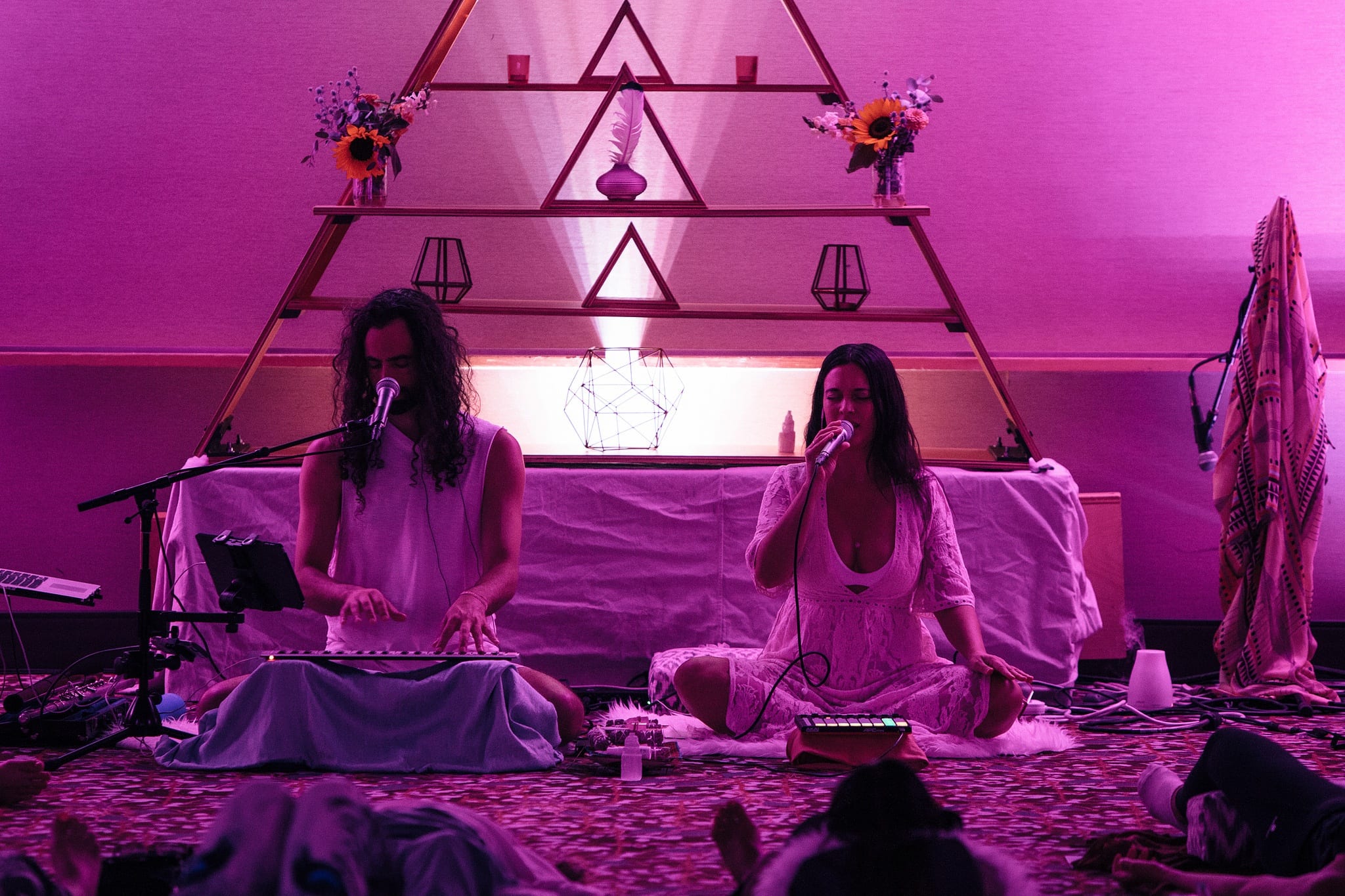
Catch Andrea Rice teaching at Wanderlust Stratton this summer! For tickets and more information, click here. Andrea is currently writing a book with Wanderlust Director of Content Lisette Cheresson, tentatively titled Season Alchemy: 52 Weeks of Yoga Wisdom, Practice, and Ritual, to be published in February 2020. For updates on the project, follow @seasonal_alchemy.
You know that moment when you sink into a deep house beat; the feeling of breath and body aligning in perfect timing with a teacher’s take-a-vinyasa cue: inhale, Urdhva Mukha; exhale, Adho Mukha Svanasana. Boom. You’re in the groove. Flowing in rhythm, lost in space, and at one with signature time, body moving like an instrument in sync with a metronome’s tempo; cadence of breath measured in quarter notes to harmonize and stabilize the ever-fluctuating mind.
What was it about that well-curated playlist that so aptly aligned to the crescendo of your practice? The answer is not so much about the music, but the magical union of mind, body, breath, and beat.
The innumerable physical benefits of a regular yoga practice have been studied extensively, from increased strength and flexibility to improved circulation and body awareness. The effects that yoga can have on the brain (like lowered cortisol levels and enhanced cognitive function) keep our monkey-minds scurrying back to our mats for more. While not every yoga teacher uses music and everyone has their individual preferences, we can all agree that there is power to an effective playlist. And even if that song or compilation or DJ-curated mix would never exist in your own iTunes library, there’s no denying that a well-crafted playlist can spark an a-ha moment in your practice.
Linking Breath to the Beat
Listening to music and practicing yoga are activities that despite their differences and origins are inherently similar: They make us feel good and enhance our wellbeing. They both speak the universal language of love. Music is as old as the human race and has remained a constant through the evolution of culture within our species. And just like yoga, studies have shown that music has physiological benefits as well. A meta-analysis of 400 studies in the journal, Trends in Cognitive Sciences, suggests that music can decrease anxiety and lower cortisol more effectively in patients about to undergo surgery than those who took anti-anxiety drugs. Though more research is needed, science has begun to realize and prove the medicinal properties of music. Recent studies have also shown that music can allow a person to enter what’s become widely recognized as a „flow state,“ a term coined by the renowned psychologist and author Mihaly Csikszentmihalyi as an „optimal state of consciousness where we feel our best and perform our best.”
Musicians, artists, and even athletes have long known about the creative flow state—before the neurobiological phenomenon made its way into the entrepreneurial and self-help realms as a booming cottage industry to increase productivity. When a flow state is reached, the brain transitions to a „borderline“ state between alpha waves, which are commonly associated with daydreaming, hypnosis, and REM sleep. That means the brain switches from firing off quicksilver beta brainwaves that are part of our normal waking consciousness, to temporarily deactivating the part of our prefrontal cortex that identifies with our sense of self. In other words, you’ve lost yourself to the moment.
Using Flow To Let Go
In a typical yoga class, we approach the idea of „flow“ as this sort of letting go, and forgetting ourselves long enough to witness the experience of our practice. With the breath as a tool and the body as the vehicle, we can become anchored into the present moment. We are in full, direct participation with the activity at hand, and we have entered Csikszentmihalyi’s flow state. In his book, Flow: The Psychology of Optimal Experience, Csikszentmihalyi writes, “The similarities between Yoga and flow are extremely strong; in fact it makes sense to think of Yoga as a very thoroughly planned flow activity. Both try to achieve a joyous, self-forgetful involvement through concentration, which in turn is made possible by a discipline of the body.”
The practice of yoga was originally intended to lead the practitioner to a meditative state. It could be determined that a state of flow is, in essence, also a meditative state. Though flow states are often described as an active engagement in a physical or mental activity where some loss of time, external awareness, or sense of self is experienced, the discipline of meditation is indeed quite active in nature, as effortless as it may seem.
For instance, when a simple mantra is recited, the meditator is focused, albeit effortlessly, on that mantra. The meditator has entered state of flow through the experience of pure bliss present moment awareness. So if it holds true that that the goal of a yoga practice is meditation, then the myriad benefits that meditation has on rewiring the brain on a cellular level, rebuilding grey matter, and lengthening telomeres to slow aging, could also be considered equally as benefits to a yoga practice that has successfully attained a flow state.
It is understandable then why your vinyasa teacher uses the common cue, “flow” to instruct a vinyasa, or why many vinyasa classes are called „flow“ classes. Vinyasa can be defined as the connection of movement to breath that transports a student from one pose to the next with fluidity, often described as “moving meditation.” If music as medication can also be thought of as a meditation, then why not invite yoga and music to work together to train the brain to reach a flow state—and stay there—and lead us toward greater fulfillment.
As Mihaly Csikszentmihalyi put it at a 2004 TED conference, “Flow is the secret to happiness and makes a life worth living.”
—
 Andrea Rice is a writer, yoga and meditation teacher, and Wanderlust Festival presenter. Her articles and essays have appeared in The New York Times, Yoga Journal, The Wanderlust Journal, NY Yoga + Life, mindbodygreen, and SONIMA, among other publications. She has been teaching yoga since 2010, first in Brooklyn and Manhattan, and now in Raleigh, NC, where she currently resides. She is also co-authoring a book about the application of seasonal rhythms and yoga philosophy to modern life, which will be published by New Harbinger in early 2020. Connect with Andrea on Facebook, Instagram, and Twitter, and sign up for her quarterly newsletters on her website: www.andreariceyoga.com.
Andrea Rice is a writer, yoga and meditation teacher, and Wanderlust Festival presenter. Her articles and essays have appeared in The New York Times, Yoga Journal, The Wanderlust Journal, NY Yoga + Life, mindbodygreen, and SONIMA, among other publications. She has been teaching yoga since 2010, first in Brooklyn and Manhattan, and now in Raleigh, NC, where she currently resides. She is also co-authoring a book about the application of seasonal rhythms and yoga philosophy to modern life, which will be published by New Harbinger in early 2020. Connect with Andrea on Facebook, Instagram, and Twitter, and sign up for her quarterly newsletters on her website: www.andreariceyoga.com.